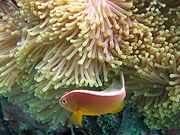| Amphiprion akallopisos | |
|---|---|
 | |
| Scientific classification | |
| Domain: | Eukaryota |
| Kingdom: | Animalia |
| Phylum: | Chordata |
| Class: | Actinopterygii |
| Order: | Blenniiformes |
| Family: | Pomacentridae |
| Genus: | Amphiprion |
| Species: | A. akallopisos |
| Binomial name | |
| Amphiprion akallopisos (Bleeker, 1853) | |
| Synonyms | |
Amphiprion akallopisus | |
The nosestripe clownfish or nosestripe anemonefish, skunk clownfish, Amphiprion akallopisos, is an anemonefish (also called clownfish) that lives in association with sea anemones. A. akallopisos is found in the Indian Ocean. [2] It resides in shallow inshore reefs as deep as 15 m with a moderate to strong current. The skunk clownfish can also be kept in captivity by aquarists.





